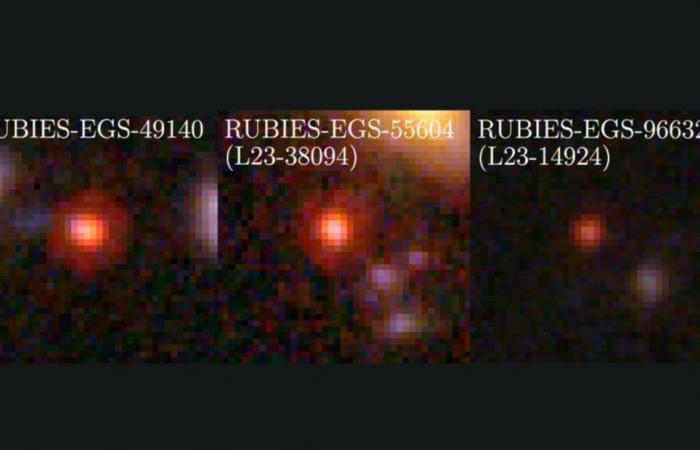MADRID, June 28 (EUROPA PRESS) –
The Webb Space Telescope (JWST) has confirmed that the luminous and very red objects detected in the early universe They challenge conventional thinking about the origins and evolution of galaxies. and its supermassive black holes.
An international team led by researchers at Pennsylvania State University using the NIRSpec instrument onboard JWST as part of the RUBIES survey has identified three mysterious objects in the early universe, some 600-800 million years after the Big Bang, when the universe was only 5% of its current age. They announced the discovery June 27 in the journal Astrophysical Journal Letters.
The team studied spectral measurements, or the intensity of different wavelengths of light emitted by objects. Their analysis found signs of “old” stars, hundreds of millions of years old, much older than expected in a young universe.
The researchers said they were also surprised to discover signs of huge supermassive black holes in the same objects, estimating them to be between 100 and 1,000 times more massive than the supermassive black hole in our own Milky Way. Neither of these features are expected in current models of galaxy growth and supermassive black hole formation, which expect galaxies and their black holes to be as large as galaxies. grow together over billions of years of cosmic history.
“We have confirmed that these appear to be packed with ancient stars, hundreds of millions of years old, in a universe that is only 600 to 800 million years old. Remarkably, these objects hold the record for the earliest signals of ancient starlight,” he said. it’s a statement Bingjie Wang, a postdoctoral researcher at Penn State and lead author of the paper.
“It was totally unexpected to find ancient stars in a very young universe. Standard models of cosmology and galaxy formation have been incredibly successful, yet these luminous objects do not fit entirely comfortably into those theories.”
Researchers first detected the massive objects in July 2022, when the initial JWST data set was published. The team published a paper in Nature several months later announcing the objects’ existence.
At the time, researchers suspected the objects were galaxies, but they continued their analysis by taking spectra to better understand the objects’ true distances as well as the sources powering their immense light.
The researchers then used the new data to paint a clearer picture of what the galaxies looked like and what was inside them. The team not only confirmed that the objects were indeed galaxies near the beginning of time, but also found evidence of surprisingly large supermassive black holes and a surprisingly old population of stars.
“It’s very confusing,” said Joel Leja, an assistant professor of astronomy and astrophysics at Penn State and co-author of both papers. “This may fit awkwardly into our current model of the universe, but only if we conjure up some exotic and incredibly rapid formation at the beginning of time. This is, without a doubt, the most peculiar and interesting set of objects I’ve seen in my career.”
JWST is equipped with infrared detection instruments capable of detecting light emitted by older stars and galaxies. Basically, the telescope allows scientists to look back in time approximately 13.5 billion years, near the beginning of the universe as we know it, said Leja.
One challenge in analyzing ancient light is that it can be difficult to differentiate between the types of objects that could have emitted the light. In the case of these early objects, they have clear characteristics of both supermassive black holes and ancient stars.
However, Wang explained, it is still unclear what proportion of the observed light comes from each, meaning they could be early galaxies that are unexpectedly old and more massive even than our own Milky Way, forming much earlier than they predict. models, or they could be more normal-mass galaxies with “supermassive” black holes, approximately 100 to 1,000 times more massive than such a galaxy would have today.
“Distinguishing between light from material falling into a black hole and light emitted by stars in these tiny, distant objects is challenging,” Wang said. “That inability to tell the difference in the current data set leaves a lot of room for interpretation of these intriguing objects. Honestly, it’s exciting to have so much of this mystery left to solve.”
Aside from their unexplained mass and age, if some of the light is coming from supermassive black holes, then they are not normal supermassive black holes either. They produce many more ultraviolet photons than expected, and similar objects studied with other instruments lack the characteristics of supermassive black holes, such as hot dust and bright X-ray emission. But perhaps most surprising, the researchers said, is how massive they appear to be.
“Normally, supermassive black holes are found paired with galaxies,” Leja said. “They grow up together and go through all their important life experiences together. But here we have a fully formed adult black hole living inside what should be a baby galaxy. That doesn’t really make sense, because these things should grow together, or at least that’s what we thought.“.
INCREDIBLY SMALL SIZES
Researchers were also perplexed by the incredibly small sizes of these systems, just a few hundred light-years across, about 1,000 times smaller than our own Milky Way. The stars are approximately as numerous as in our own Milky Way galaxy, with between 10 billion and 1 trillion stars, but contained in a volume 1,000 times smaller than the Milky Way.
Leja explained that if we took the Milky Way and compressed it to the size of the galaxies they found, the closest star would be almost in our solar system. The supermassive black hole at the center of the Milky Way, about 26,000 light years away, would be only about 26 light years from Earth and would be visible in the sky as a giant pillar of light.






